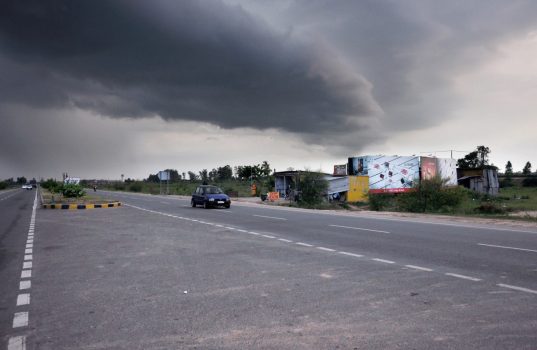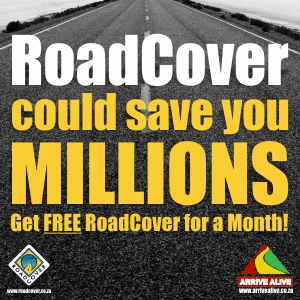Safe Driving in Bad Weather Conditions
Introduction
At some stage all drivers are challenged by bad weather conditions. Many unfortunately underestimate the adjustments needed in driving technique. Researchers and statisticians in the U.S. found that 24% of all crashes occur during adverse weather conditions, including ice, snow, and rain.
In South Africa we are accustomed to driving in beautiful sunny weather most of the time. Many a young driver has a drivers’ licence but has never had to deal with the challenges presented by adverse weather conditions. It is the duty of the driver to know how to adjust his driving to meet conditions on the road he travels.
In this section we would like to provide some insights and advice on how to drive in adverse weather. There are several detailed discussions on specific weather conditions on the Arrive Alive website. We would like to discuss some of the general techniques for safe driving in most of these challenging conditions.
Adverse weather conditions and unique challenges on the road
Adverse weather conditions can be described as those conditions brought about by changes in weather requiring the driver to exercise special caution and adjust his normal driving behaviour.
These conditions tend to reduce the visibility of the driver as well as his ability to safely steer or apply braking to the vehicle.
Adverse weather conditions include driving in:
- Rain
- Flooding
- Snow
- Fog and Mist
- Hail storms
- Smoke from veld and forest fire
- Strong winds
- Extreme cold and hot weather
- Driving toward the sun from sunrise to sunset
We need to recognize that these conditions may present rather unique challenges to the driver. These would include:
- Reduced visibility
- Reduced steering ability
- Reduced traction
- Increased time and space required to bring the vehicle to a stop.

Extreme weather requires special skills from the driver to be safe on the road.
- Wet road surfaces can cause tyres to hydroplane (skim on a thin layer of water).
- Wind creates additional problems for drivers as it reduces steering control.
- It can be especially dangerous for recreational vehicles and vehicles towing trailers.
- High sided vehicles and motorcyclists are particularly vulnerable to strong winds.
- Crosswinds may cause the car to swerve, especially SUVs and vans.
- Sudden gusts of wind may present a unique risk as you cross a culvert or bridge, or drive through mountain passes and ravines.
- You may also encounter a small gust when being passed by a large truck or bus.
The rather unique challenges are not only having an effect on your own steering and ability to control the vehicle, but also on your awareness with regards to other road users and objects.
- A driver needs to take special care when driving behind goods vehicles as they generate a considerable amount of spray which reduces your visibility. It is best to hold back to where you can see their mirrors.
- Adverse weather and strong winds may increase the chances of falling/fallen debris on the road and vehicles veering across the road to avoid such debris.
- Surface water may contain hidden objects that could cause you to stall or damage your tyres.
- Increased awareness is required of vulnerable road users such as pedestrians, cyclists and motorcyclists and the need to allow extra space.
- They too may be trying to avoid the mud and slippery side of the road.
- It is best to avoid moving off the road under trees that might fall on your vehicle.
- Also remain alert to animals at roadside where fences may be down.
- Adverse weather conditions may cause power lines to go down next to and on the roads –be alert and avoid downed power lines.
- Smoke from forest or brush fires can be dangerous to drive through, because it can occur suddenly, without warning, and be very dense.
- Clouds of sand can also significantly reduce visibility.
- Some drivers may not be using the headlights as is required by law – Rather avoid overtaking in conditions of poor visibility.
Aspects to consider before driving in bad weather
Most of us not caught off-guard by sudden changes in weather have the option whether to confront these challenging driving conditions or rather to avoid them. The best way to be safe in extremely bad weather is to avoid driving at all. Even for the experienced driver with the best vehicle the best way to avoid an accident or problem on the road in stormy weather is just to stay at home and wait for the weather to improve. If possible, it is best to postpone a trip and stay home rather than drive if there is an extreme weather system moving through your area.
For those who need to be on the road it is essential to plan ahead for the drive! Driving in bad weather usually takes longer and is more stressful. Not allowing enough time to reach the destination will increase your stress level and could adversely affect your driving. By planning ahead for the bad weather and the problems it may throw at you, you will be better prepared to handle unfortunate situations if they do happen to you.

Driver Fitness and Safe Driving in Adverse Weather Conditions
A safe driver should strive to be physically fit, healthy and in the best condition possible for the challenges that extreme weather might throw at him.
In adverse weather conditions it is even more important to be alert, using all your senses to identify potential dangers.
- Most importantly the driver needs to have clear vision – make sure you are able to see!
- Always remember -if you cannot see a safe distance ahead you should not be driving.
- In traffic with limited visibility you should also be able to listen to traffic.
- Avoid loud music on the radio and other driver distractions.
- Avoid driver fatigue by keeping the vehicle well ventilated.
- Only drive when well rested – you will need all your concentration when driving in extreme weather!
Vehicle Fitness and Driving in Bad Weather
The safe driver will be well aware of the need to have a vehicle best equipped to drive safely in bad weather and not break down!
We would advise a complete pre-trip inspection with a focus on the following:
- Do a visual, hands-on inspection and check all important items, including tyres, wiper blades, fluid and lights.
- Check that wiper blades are not worn and are capable of clearing the windscreen correctly.
- When it’s your safety, your family’s safety, and the safety of others on the line the cost to purchase a decent set of windshield wipers is a small price to pay.
- Don’t forget to check the spare tyre.
- Tyre tread is very important especially on slippery roads allowing you to slow down and stop suddenly should the need arise.
- Guard against “over” and “under” inflated tyres and potential loss in traction.
- Check the battery, antifreeze, windshield wiper fluid, headlights.
- Ensure that lights are clean and number plates are clearly visible and legible.
- Headlamps, turn signals, and hazard signals are imperative in bad weather driving conditions.
- Be Visible Be Seen: The more visible you are the less likely it is that somebody will hit you, and it’s always a good idea to be able to see in front of you when you’re driving, regardless of the weather outside your vehicle.
- Check that mirrors are clear and the windows are demisted thoroughly.
- When driving in hot weather, keep an eye on the warning lights and gauges, especially the temperature gauge.
- Be sure to have enough fuel for a delayed journey.

Emergency preparedness for bad weather driving
Once you are confident in your own driving ability and that your vehicle is in the best condition to drive in the bad weather, there are a few basic steps to prepare you for the drive:
- Listen and obey national and local radio/TV announcements and warnings regarding road and weather conditions for your journey.
- Do not attempt to cross at a river crossing where the road has been closed-no matter how big your vehicle is!
- Buckle Up! – Be sure you and your passenger’s wear seatbelts at all times. Not only is it the law, it can also save lives, especially when driving in bad weather.
- Look out for signs warning of adverse conditions – including fixed signs, such as those warning of exposure to high-winds, and variable message signs on motorways that warn of fog, snow and which may display temporary slower speed limits.
- In the event of journeys of a necessary nature inform family/friends of your estimated time of arrival (ETA) and carry a mobile phone.
- Ensure your mobile phone is charged and have a car charger ready – You may get stranded and need to call for help.
- If you are to be prevented from driving further –be prepared to get off the road.
If in a worst case scenario you do get stranded in snow or cold you will wish to be prepared. You can buy or even create an emergency kit to have in your car before departure. This could include
- Protective clothing and blanket, including high visibility jacket and a torch/flashlight with batteries.
- Water, snack foods like high-calorie fruit bars, granola bars, nuts etc.
- If you have the space and may be travelling in snow consider keeping extra clothing, snow boots, flares, a shovel, and even strips of carpeting to place under your tyres if your vehicle becomes stuck.
- First-aid kit
- Battery jump leads
- A GPS navigation device or map for any unplanned diversions
- A towing rope

Safe Driving techniques in bad weather
Once you get caught on the road in bad weather conditions it is important to follow the following safe driving techniques:
- Make sure your headlights are on –Be Visible Be Seen!
- Obey all road and traffic signs- Safety authorities post this information with good reason.
- Be alert and drive defensively.
- Be prepared for the road conditions to change over relatively short distances.
- Allow yourself enough time and space to react to a sudden emergency and move from harm’s way or to come to a stop safely.
- Increase your following distance – Remain well behind the road user in front as stopping distances can be ten times greater than on dry roads.
- Slow down. Braking takes longer on slippery roads — the slower you go, the easier it will be for you to maintain control and stop your vehicle.
- Don’t slow down so much that you become a risk to other drivers – Rather move off the road surface than getting to a complete stall in areas of poor visibility.
- Be aware that in reduced visibility conditions, drivers tend to follow the tail lights of vehicles in front of them.
- Use special caution near intersections. Never assume that because you have the green light or the right of way that the intersection will be clear — always scan ahead to spot potential hazards.
- Avoid unnecessary lane changes – Stay in one lane as much as possible
- Keep two hands firmly on the wheel and two eyes on the road at all times.
- Remain alert by continuously scanning the whole area.
- Drive extremely carefully when the roads are icy. Avoid sudden actions as these could cause loss of control.
- Accelerate and brake very gently – Drive particularly slowly on bends where loss of control is more likely.
- Brake progressively on the straight before you reach a bend. Having slowed down, steer smoothly round the bend, avoiding sudden actions.
- Be careful near elevated structures, such as bridges and highway overpasses, as they usually freeze first.
- If you get stuck in a bad storm or blizzard and you can’t see a close place to seek assistance, stay put! It’s easy to get confused in a bad storm, and you may get lost.
- Stay in the car and turn on the emergency flashers until the conditions improve or help arrives.
- If you get stuck – avoid carbon monoxide poisoning by keeping the exhaust pipe clear of snow, and open a downwind window slightly for ventilation.
- When you encounter problems when driving in extreme heat –do not attempt to remove the radiator cap when your car is hot, and do not pour water over a hot radiator or engine. You must wait a sufficient amount of time until your engine cools.
- Never leave a child or pet in a parked car in extremely warm weather.

What to do in an emergency to avoid a crash
The safe driver will always consider worst case scenarios and what to do in an emergency situation. The driver who knows what to do in an emergency is more likely to stay in control. What do we need to now in the event of a skid on slippery roads?
- Identify the cause – It is either, Too much Braking, Too much Steering, Too much Acceleration or a combination of one or all of these.
- Remove the cause gently and smoothly
- If your vehicle has ABS it will not skid under braking. If ABS is activated, keep your foot on the brake and steer around that what caused you to brake.
- If your vehicle does not have ABS and starts to skid on the brakes, pump the brake pedal very fast (Cadence Braking) and steer around that what caused you to brake.
- If your vehicle skids and slews sideways -Turn the steering wheel in the same direction as the skid and ease off the accelerator at the same time.
- Avoid over correction with too much steering.
- Always look and steer toward your intended path of travel. Keep your eyes focused on where you want the vehicle to go.
- Be ready for a secondary skid.
We would like to encourage driver alertness with regards to your own driving, the driving of others and well as the surroundings! If you observe a car or truck driving too quickly for the conditions, put some distance between you and their vehicle. If you see a vehicle in front of you starting to lose control, you’ll need to make split-second checks for vehicles coming up behind you, potential dangers beside you, all while making a decision on how you need to react in case another driver loses control of their vehicle.
If a crash cannot be avoided you may have to choose the lesser of two evils. If there’s concrete to your left and a steep ditch to your right, or a forest right off the road – you need to keep these things in mind while you’re driving so that you can make informed split-second decisions about the safest place to steer your vehicle in case of an emergency.
Conclusion
It is our wish that more drivers can make informed decisions on the roads. The more safety awareness we gain and apply in our driving on the roads, the better we are able to prevent and reduce road crashes. We will continue to search and share the advice from safe driving experts across the world in our efforts towards safer roads!
– See more at: http://www.arrivealive.co.za/pages.aspx?i=1347&page=Safe-Driving-in-Bad-Weather-Conditions#sthash.hmG94jOa.dpuf
Related Posts
« Farm attack leaves female critically injured Kempton Park pedestrian accident leaves one dead »
























